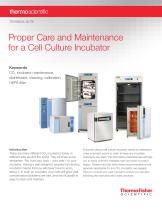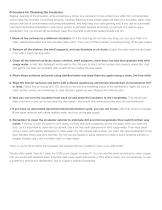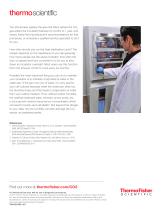
Excertos do catálogo

TECHNICAL NOTE Proper Care and Maintenance for a Cell Culture Incubator Keywords CO2 incubator maintenance, disinfectant, cleaning, calibration, HEPA filter Introduction There are many different CO2 incubators today, in different labs around the world. They all share some similarities. You trust your work – your cells – to your incubator. Having a well designed, properly functioning incubator means that you will never have to worry about it. In such an incubator, your cells will grow well, contamination problems are rare, and the incubator is easy to clean and maintain. Everyone using a cell culture incubator needs to understand a few important points in order to keep any incubator working its very best. The information presented here will help you to avoid common mistakes that can result in project delays. Please note that while these recommendations are generally applicable for any CO2 incubator, we suggest that you consult your user manual to ensure you are also following the manufacturer’s best practic
Abrir o catálogo na página 1
Where you place the incubator can alter its performance. Ventilation, air flow, room temperature, and direct sunlight can all affect the temperature and humidity functions. When installing a CO2 incubator, be sure to lift only by the sides of the bottom, never from front and back – and do not ever lift using the door. Position the incubator on a firm, level surface away from any vibration source. Do not place any incubator directly on the floor. Instead, use a support stand. If the incubator sits directly on the floor, the air movement that is created each time the door is opened will sweep...
Abrir o catálogo na página 2
There are two kinds of CO2 gas sensors. The first is the T/C (thermal conductivity) sensor. Thermo Scientific incubators offer a T/C sensor and electronics that are very stable, accurate and economical. In fact, T/C sensors are our most popular method of CO2 control. They are long-lasting, comparatively inexpensive and robust. An IR (infrared) sensor is preferred for some applications including cGMP monitoring, or when the incubator door is opened repeatedly over a short period; for example, when performing time lapse expression analyses. Some manufacturers have a design that places the...
Abrir o catálogo na página 3
because dust and dirt among these items can be swept inside the chamber with air currents created during a door opening. Remember to also clean the corners of the lab and on top of and under equipment where dust can collect. Incubator Disinfectants Many researchers ask: which disinfectants are okay to use in the CO2 incubator? The truth is that there are many disinfectant options available, but not all are safe for your cells or for incubator components. Some strong disinfectants may give off fumes that enter the incubator and then affect cell growth. These fumes contain VOCs (volatile...
Abrir o catálogo na página 4
Procedure for Cleaning the Incubator Regular cleaning of the incubator, while sometimes a chore, is a necessity to help protect your cells from contamination and to keep the incubator functioning properly. Carefully following these simple steps will keep your incubator clean, help reduce chances of contamination becoming established, and help keep your cells growing well. If you use an automated heat decontamination/sterilization cycle that is proven to eliminate bacteria and fungi, you should not need to use a disinfectant, but you should still periodically clean the incubator to eliminate...
Abrir o catálogo na página 5
Importance of Correct Water To provide the proper humidity required by your cultured cells, we recommend only sterile distilled water. Tap water with even small amounts of chlorine can corrode stainless steel or pure copper. Also, tap water can contain lots of bacteria and minerals. Since salts and minerals are precisely balanced in cell growth media, adding minerals via the water to the humidified atmosphere can cause poor cell growth. DI (de-ionized) or ultra-pure Type 1 water is very aggressive. It corrodes Thermo Scientific stainless steel because the water, Barnstead Classic Still...
Abrir o catálogo na página 6
You should also replace the gas inlet filters (where the CO2 gas enters the incubator) between 6 months to 1 year, and simply follow the manufacturer’s recommendations for that procedure, or schedule a qualified service specialist to do it for you. How often should you run the heat sterilization cycle? The answer depends on the cleanliness of your lab generally, how many people use the same incubator, how often the door is opened and how convenient it is for you to shut down an incubator overnight. Most users use this function from one time per month to once every six months. Probably the...
Abrir o catálogo na página 7Todos os catálogos e folhetos técnicos Thermo Scientific
-
CryoStar NX50
2 Páginas
-
Precise sections – perfectly simple
6 Páginas
-
MSC-Advantage BSC
54 Páginas
-
Multifuge
58 Páginas
-
Sorvall WX+ Ultracentrifuge Series
8 Páginas
-
Thermo Scientific Pico 17 / 21
52 Páginas
-
Forma Series II Water Jacket CO2 Incubator
104 Páginas
-
CO2 Incubator HERAcell 150 i / 240 i
196 Páginas
-
Revco® Blood Bank Refrigerators
37 Páginas
-
Multidrop Combi nL
4 Páginas
-
Forma Environmental Chambers
25 Páginas
-
MaxQ 6000
40 Páginas
-
Multi Tube Rotator
13 Páginas
-
picoSpin Spectrometer
6 Páginas
-
1300 Series A2
76 Páginas
-
CO2 Incubator Family
28 Páginas
-
Series 8000 Direct-Heat CO2 Incubators
84 Páginas
-
MaxQ Mini 4450 Shaker
40 Páginas
-
E1-ClipTip Electronic Pipette
108 Páginas
-
Varioskan™ LUX
54 Páginas
-
Spinnaker Advanced Benchtop Robot
2 Páginas
-
ISQ Series Mass Spectrometers
412 Páginas
-
Thermo Scientific GasBench II
8 Páginas
-
Q Exactive™ BioPharma
16 Páginas
-
Q Exactive Plus
4 Páginas
-
LTQ XL™
4 Páginas
-
Thermo Scientific Exactive Plus
4 Páginas
-
Platinum DNA polymerases
6 Páginas
-
-80°C Benchtop Freezer
2 Páginas
-
Heratherm Heating and Drying Ovens
20 Páginas
-
Thermo Scientific Benchtop Shakers
28 Páginas
-
Nicolet iS10 FT-IR Spectrometer
12 Páginas
-
Nunc Cell Factory Shaker System
8 Páginas
-
mySPIN Mini Centrifuge Series
4 Páginas
-
Anza Restriction Enzyme Cloning System
12 Páginas
-
Ion S5 and Ion S5 XL Systems
2 Páginas
-
SureTect Range
4 Páginas
-
QuantStudio™ 3
8 Páginas
-
Furnaces
2 Páginas
-
Nunc Serological Pipettes
3 Páginas
-
Nunc Cell Factory system equipment
4 Páginas
-
Nunc Cell Factory systems
8 Páginas
-
Vanquish Duo UHPLC System [ZH]
12 Páginas
-
native MS
16 Páginas
-
Compound Discoverer Software
12 Páginas
-
Vanquish Horizon UHPLC System
16 Páginas
-
Sentinel Multiscan Metal Detector
4 Páginas
-
Continuous Flow Isotope Ratio MS
5 Páginas
-
Thermo Scientific TSQ Duo
9 Páginas
-
Thermo Scientific TSQ 8000 Evo
16 Páginas
-
Nunc Cell Factory System Equipment
4 Páginas
-
Heraeus Labofuge 300
2 Páginas
-
Heraeus Labofuge 200 Centrifuge
2 Páginas
-
Heraeus Cryofuge 5500i
8 Páginas
-
Heraeus Clinifuge Centrifuge
2 Páginas
-
Vials and Closures Catalog 2014-2015
128 Páginas
-
Heratherm Large Capacity Ovens
2 Páginas
-
RM 200 EG
4 Páginas
-
Darwin LIMS
2 Páginas
-
Immunohistory Solutions
292 Páginas
-
Remel and Oxoid Product Catalog, Europe
84 Páginas
-
Foodborne Pathogens Testing Guide
32 Páginas
-
Finnpipette Finntip Product Catalog
40 Páginas
-
Process Water Products Catalog
68 Páginas
-
Technical Training Catalog
15 Páginas
-
Smart-Vue Wireless Monitoring Solution
16 Páginas
-
Reagents, Solvents and Accessories
56 Páginas
-
FBS Alternatives
8 Páginas
-
European Prepared Media Selection Guide
66 Páginas
-
iCAP Q Consumables and Parts Catalog
7 Páginas
-
LC Columns and Accessories Catalog 2014-2015
246 Páginas
-
Pierce Magnetic Beads
16 Páginas
-
Thermo Scientific TRACE 1300 Series
12 Páginas
-
interactive catalog today
222 Páginas
-
HERAGUARD HPH clean benches
2 Páginas
-
Forma 1800 Series Clean Bench
2 Páginas
-
MBC 240 Bench Top Analyzer
4 Páginas
-
Konelab 20
2 Páginas
-
Indiko
6 Páginas


























































































![ISQ 7000 Single Quadrupole GC-MS System VPI [ZH]](https://img.medicalexpo.com/pdf/repository_me/78678/isq-7000-single-quadrupole-gc-ms-system-vpi-zh-191148_1mg.jpg)
![ISQ 7000 Single Quadrupole GC-MS System [ZH]](https://img.medicalexpo.com/pdf/repository_me/78678/isq-7000-single-quadrupole-gc-ms-system-zh-191147_1mg.jpg)
![Vanquish Duo UHPLC System [ZH]](https://img.medicalexpo.com/pdf/repository_me/78678/vanquish-duo-uhplc-system-zh-191145_1mg.jpg)






















































![Thermo Scientific Herasafe KS and KSP Class II Biological Safety Cabinets [EN]](https://img.medicalexpo.com/pdf/repository_me/78678/thermo-scientific-herasafe-ks-and-ksp-class-ii-biological-safety-cabinets-en-85081_1mg.jpg)

























